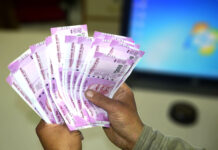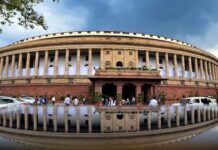At the core of state budget is a serious push to public spending so that the economy moves out of the shadows of GST-demonetization impact. Basic arithmetic suggests the employees of the state government are the main key to the intervention, reports Masood Hussain

The positivity that the budget proposals for the fiscal 2018-19 generated in last fortnight have its base in the negativity that J&K’s economic scene is exhibiting. At one point in time, after 2001, when markets exhibited surge for unprecedented credit appetite, budget seemed sort of a balance sheet of a government that perpetually lacked either legitimacy or authority.
Two restive summers and a severe flood after, the economy is back to the traditional low. Successive tourist season failures, surging liabilities, protracted working capital cycles have compromised capacity for debt servicing and dried credit off-take. Accelerated by demonetization and disruptive systemic shift by the GST takeover, this has slowed down the overall growth. The budget for the next fiscal has the focus to undo these effects and that is where the entire positivity is emanating from.
In plain terms, Dr HaseebDrabu, state’s finance minister, is keen to shoot up the public spending so that it alters the current liquidity stagnation and economy finds some direction to come out of the morass, the situation has forced it into. “J&K’s entire economic system involving every section of the society has landed up in a serious fiscal crisis because of various long and short-term reasons including protracted political turmoil, 2014 floods, 2016 disturbances, demonetization, and GST,” Drabu told the lawmakers. “The only way to set the economy on the recovery and revival path is to enhance autonomous public expenditure. We have announced various measures in this budget so that money keeps continuously flowing and circulating in the system to keep the economy enduring.”
People understanding this mantra are asking three pertinent questions: Is the money really huge? Where is the public money going? And will it make an impact?
J&K plans to spend Rs 80313 crore, almost 9000 crore in excess of the spending in 2017-18, the current fiscal. There are three expenditures that are sort of “capital flight” and will essentially move out: Rs4725 crore of interest on accumulated debts, Rs 7400 crore as power purchase bill and Rs2727 as repayment of debts. By and large, the rest of the money, if spent, shall remain within the state and, mostly get into the local economy.
One is the capital expenditure – public funds that get into the creation of assets. Though routine, budget papers indicate there will be Rs 22792 crore available to the state government for various developmental activities. It is more than Rs 4000 crore than the money anticipated to have gone into the creation of assets in 2017-18.
The committed expenditures of the state government, the Revenue Expenditure, are quite a huge sum, always. It is the second major carrier of taking public money from the coffers to the market. Main ingredients of this are the funds that go into the wage bill, pensions and other welfare measures for them. This is where Drabu’s main emphasis was located. The J&K government has 503537 employees on its rolls in addition to those serving its loss-making PSUs, aided institutions and municipal bodies. Now, it has started elevating the position of the daily-wagers by giving them cooperatively respectable wages. Their number is not less than 60,000 but can double.

In fiscal 2018-19, an amount of Rs 23863 crore will go as salaries, Rs 5100 crore of pension to retired employees. This is in addition to the budgetary support that various loss-making PSU would be getting. Though the formal re-organisation of daily-wagers has barely started, their yearly costs are expected to touch Rs 800 crore plus and that is not reflected in the budget estimation.Drabu says more than 25 lakh population in J&K is directly linked to the government.
In comparison to last two years, the outgo on wage bill is substantial. Against Rs 16534.56 crore in 2016-17 and Rs 19261.73 crore in 2017-18, the wage bill alone is of the order of Rs 25690.24 crore in 2018-19. Part of the increase is because of the seventh pay commission implementation.
With Rs 30790.24 crore being taken by the government employees, it essentially means more than 38 percent of the entire budget goes to government employees. If the share of wage bill is calculated after the net outgo of the cumulative resource of Rs 14852 crore capital as debt, interest payment and power bill to the public finance system outside Jammu & Kashmir state, the importance of government employees become more important. They take more than 47 percent home from the balance funds. This is perhaps why Drabu’s budget terms them amongst main stakeholders.
While this situation is making sector quite lucrative, and the private jobs highly unattractive, the wisdom is doing this is simple: “When any section of the society has money and it spends or even it saves, it helps the economy.”
Thirdly, Drabu took a liability management route to address the trade, including retail and industry. His emphasis was reducing the liability. “When we announce some amnesty, we actually write off somebody’s liability and when there is no liability, it automatically becomes income,” he said. He set aside Rs 200 crore to fund the interest liability of all the flood-soaked accounts for three months in a year.
The budget also foregoes a sum of Rs 150 crore that was outstanding on account of various penalties and other costs against various businesses in the VAT regime, mostly under toll tax head, that was replaced by GST in July 2017. He also closed down two toll posts, one each at Lower Munda (on Jammu Srinagar highway) and Hirpora (Mughal Road) which would fetch Rs 22 crore a year. The toll on all export items from the state was withdrawn. For the first time, hospitality sector moved beyond the basic tax exemptions and was formally accepted as an industry. Now hotel buildings will be considered as plant and machinery thus getting a Central Capital Investment subsidy of 30 percent, 3 percent interest subsidy for five years and 100 percent insurance subsidy under the scheme.
Fourthly, the budget has taken the welfare route to address some of the critical concerns of the common masses especially the marginalised classes. Though no direct money is given anywhere, small public money has intelligently gone to the areas, which can alter the welfare of the concerned.

All banks are offering educational loans but the product is not very popular because of the interest burden. By the end of September 2017, official data suggest that banks had advanced only Rs 4.85 crore in 87 cases! The overall outstanding by September 2017, was Rs 315.56 crore against 13299 individuals. To make the scheme work, the government from now on will pay the interest liability in case of all educational loans for the full course after the students get admission in best universities outside J&K, offshore included. This will help an economically low segment to avail the best education.
Extending the BPL status to trans-genders, not more than 700 souls across J&K, might be a major step for the microscopic community but extending insurance cover to the families of three lakh construction workers is a major step. He added Rs 30 crore to the existing corpus that funds the pensions to old aged and the widowed population that has as many as 217777 cases pending for last many years.
The element of populism apart, the major issue is, if at all the money is spent and what is the quantum and quality of expenditure. J&K has serious spending limitations and that is the reason why part of the Capex funds remain unspent at the end of the financial year.
Off late, the state government has started including part of the PMDP to its spending estimations. But for major projects, the systems of implementation are complex and the size of local companies is small as a result, of which this entire money is spent by no-local actors. While this helps the state to address the infrastructure deficit, it does not improve growth. In most of the projects, the state gets cost of the land that is at the core of a major debate about whether money for land is empowerment or dispossession.
In this backdrop, the key to public spending lies with the government employee. Will s(he) spend the money? In conflict spots, moneyed usually hedge risks by making long-term investments or simply staying liquid. Let us see if that sees some change.















